(PDF) Integrated Reporting: The Future of Corporate Reporting
VerifiedAdded on 2021/09/20
|15
|4085
|249
AI Summary
Contribute Materials
Your contribution can guide someone’s learning journey. Share your
documents today.
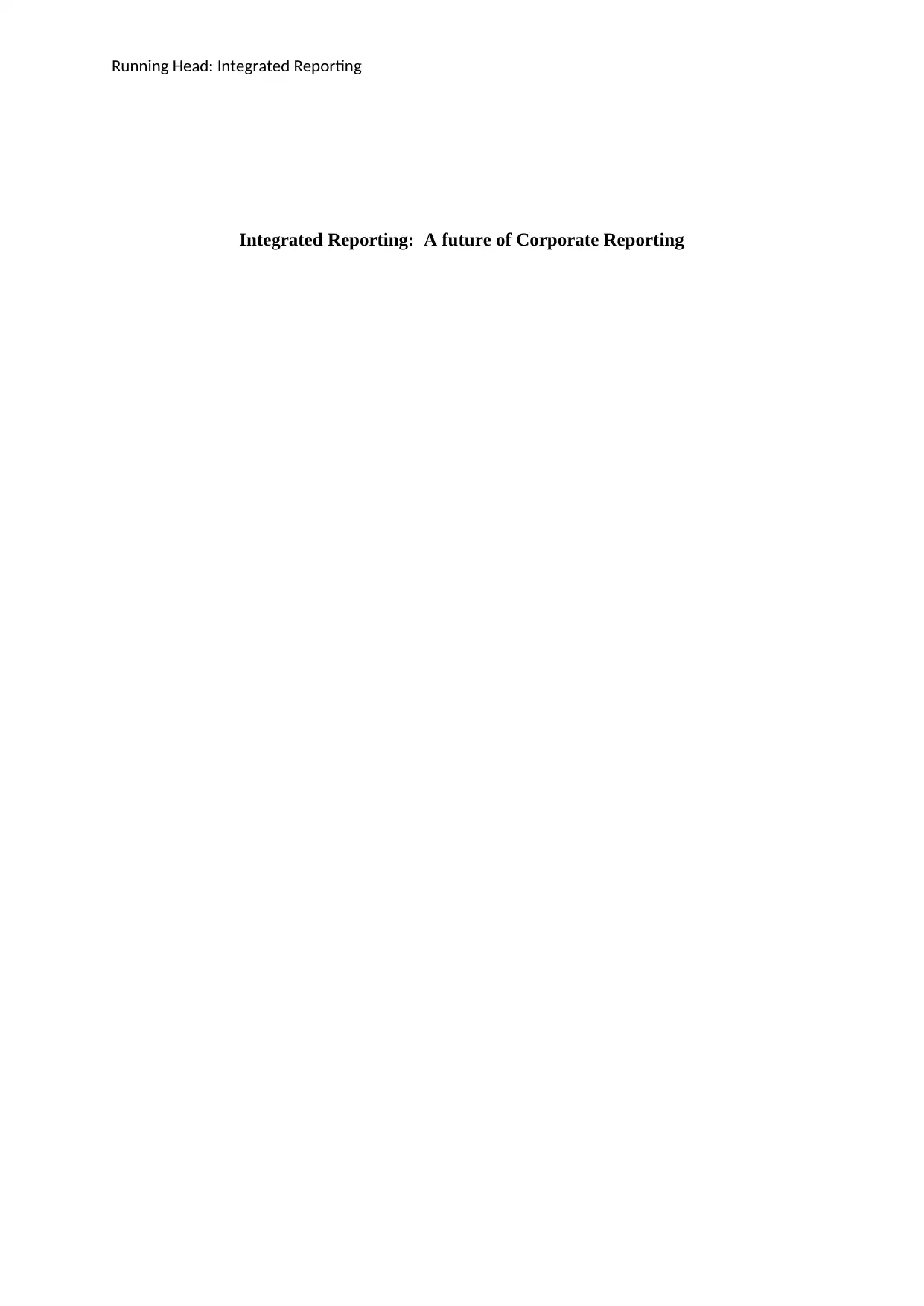
Running Head: Integrated Reporting
Integrated Reporting: A future of Corporate Reporting
Integrated Reporting: A future of Corporate Reporting
Secure Best Marks with AI Grader
Need help grading? Try our AI Grader for instant feedback on your assignments.
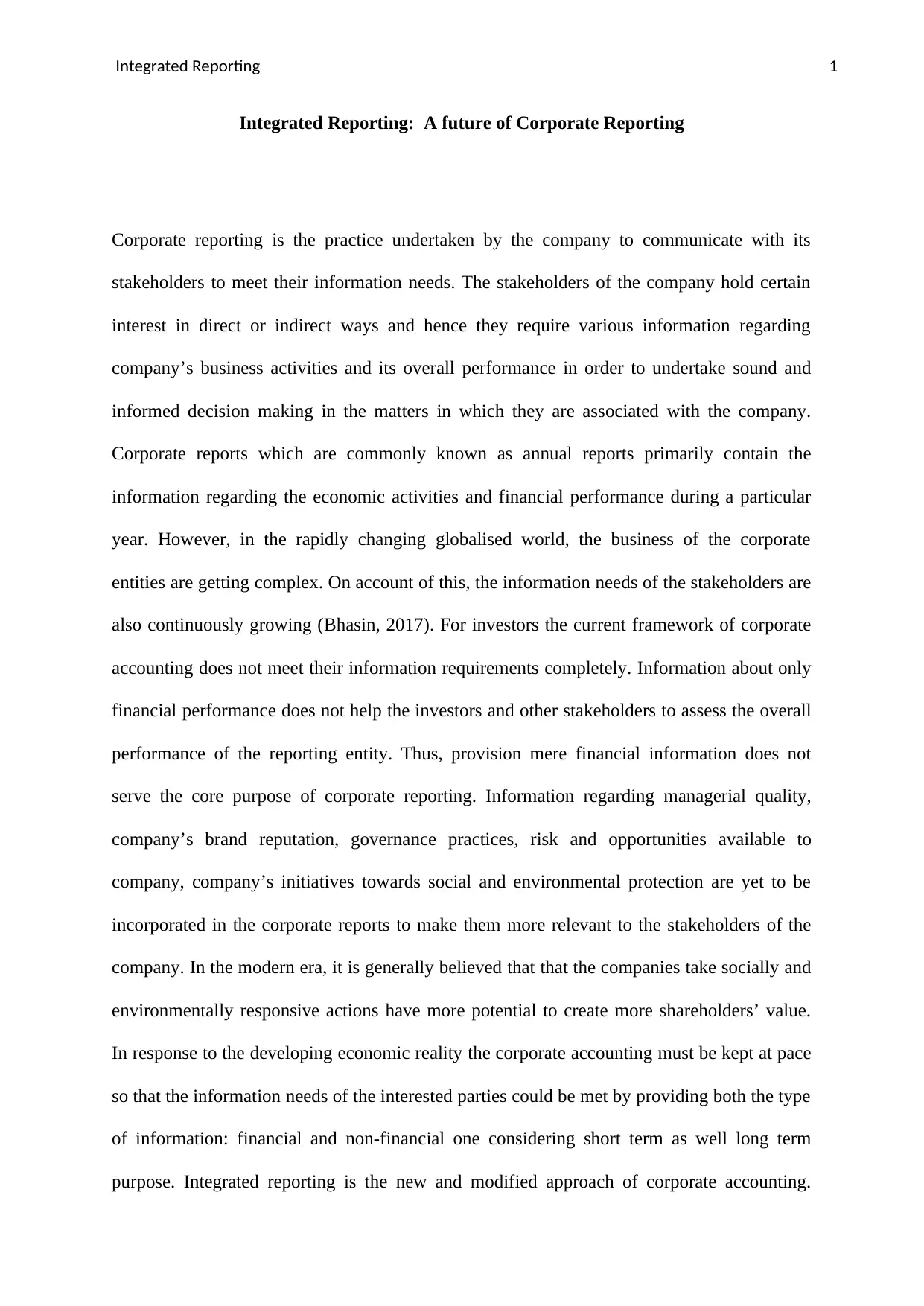
Integrated Reporting 1
Integrated Reporting: A future of Corporate Reporting
Corporate reporting is the practice undertaken by the company to communicate with its
stakeholders to meet their information needs. The stakeholders of the company hold certain
interest in direct or indirect ways and hence they require various information regarding
company’s business activities and its overall performance in order to undertake sound and
informed decision making in the matters in which they are associated with the company.
Corporate reports which are commonly known as annual reports primarily contain the
information regarding the economic activities and financial performance during a particular
year. However, in the rapidly changing globalised world, the business of the corporate
entities are getting complex. On account of this, the information needs of the stakeholders are
also continuously growing (Bhasin, 2017). For investors the current framework of corporate
accounting does not meet their information requirements completely. Information about only
financial performance does not help the investors and other stakeholders to assess the overall
performance of the reporting entity. Thus, provision mere financial information does not
serve the core purpose of corporate reporting. Information regarding managerial quality,
company’s brand reputation, governance practices, risk and opportunities available to
company, company’s initiatives towards social and environmental protection are yet to be
incorporated in the corporate reports to make them more relevant to the stakeholders of the
company. In the modern era, it is generally believed that that the companies take socially and
environmentally responsive actions have more potential to create more shareholders’ value.
In response to the developing economic reality the corporate accounting must be kept at pace
so that the information needs of the interested parties could be met by providing both the type
of information: financial and non-financial one considering short term as well long term
purpose. Integrated reporting is the new and modified approach of corporate accounting.
Integrated Reporting: A future of Corporate Reporting
Corporate reporting is the practice undertaken by the company to communicate with its
stakeholders to meet their information needs. The stakeholders of the company hold certain
interest in direct or indirect ways and hence they require various information regarding
company’s business activities and its overall performance in order to undertake sound and
informed decision making in the matters in which they are associated with the company.
Corporate reports which are commonly known as annual reports primarily contain the
information regarding the economic activities and financial performance during a particular
year. However, in the rapidly changing globalised world, the business of the corporate
entities are getting complex. On account of this, the information needs of the stakeholders are
also continuously growing (Bhasin, 2017). For investors the current framework of corporate
accounting does not meet their information requirements completely. Information about only
financial performance does not help the investors and other stakeholders to assess the overall
performance of the reporting entity. Thus, provision mere financial information does not
serve the core purpose of corporate reporting. Information regarding managerial quality,
company’s brand reputation, governance practices, risk and opportunities available to
company, company’s initiatives towards social and environmental protection are yet to be
incorporated in the corporate reports to make them more relevant to the stakeholders of the
company. In the modern era, it is generally believed that that the companies take socially and
environmentally responsive actions have more potential to create more shareholders’ value.
In response to the developing economic reality the corporate accounting must be kept at pace
so that the information needs of the interested parties could be met by providing both the type
of information: financial and non-financial one considering short term as well long term
purpose. Integrated reporting is the new and modified approach of corporate accounting.
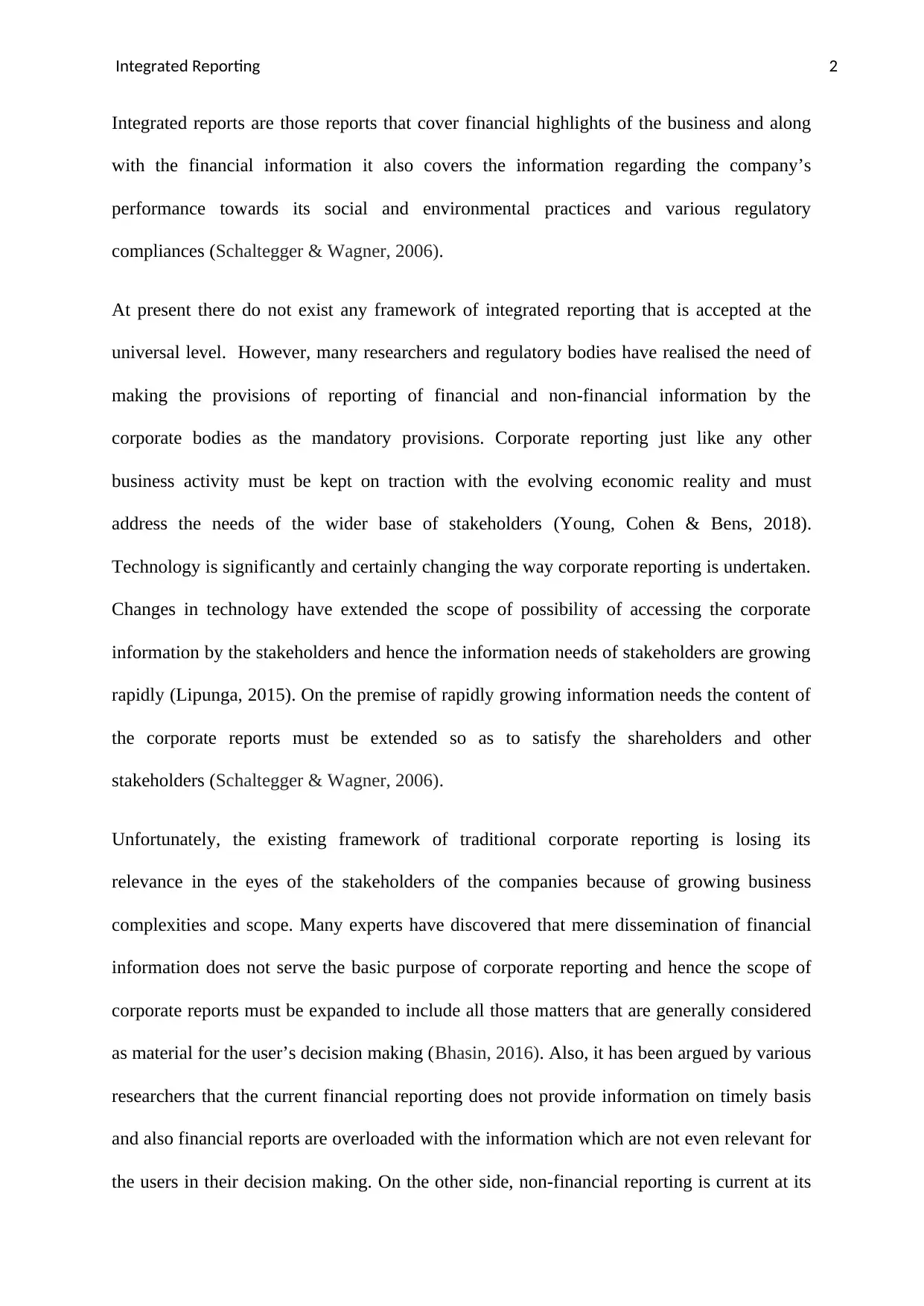
Integrated Reporting 2
Integrated reports are those reports that cover financial highlights of the business and along
with the financial information it also covers the information regarding the company’s
performance towards its social and environmental practices and various regulatory
compliances (Schaltegger & Wagner, 2006).
At present there do not exist any framework of integrated reporting that is accepted at the
universal level. However, many researchers and regulatory bodies have realised the need of
making the provisions of reporting of financial and non-financial information by the
corporate bodies as the mandatory provisions. Corporate reporting just like any other
business activity must be kept on traction with the evolving economic reality and must
address the needs of the wider base of stakeholders (Young, Cohen & Bens, 2018).
Technology is significantly and certainly changing the way corporate reporting is undertaken.
Changes in technology have extended the scope of possibility of accessing the corporate
information by the stakeholders and hence the information needs of stakeholders are growing
rapidly (Lipunga, 2015). On the premise of rapidly growing information needs the content of
the corporate reports must be extended so as to satisfy the shareholders and other
stakeholders (Schaltegger & Wagner, 2006).
Unfortunately, the existing framework of traditional corporate reporting is losing its
relevance in the eyes of the stakeholders of the companies because of growing business
complexities and scope. Many experts have discovered that mere dissemination of financial
information does not serve the basic purpose of corporate reporting and hence the scope of
corporate reports must be expanded to include all those matters that are generally considered
as material for the user’s decision making (Bhasin, 2016). Also, it has been argued by various
researchers that the current financial reporting does not provide information on timely basis
and also financial reports are overloaded with the information which are not even relevant for
the users in their decision making. On the other side, non-financial reporting is current at its
Integrated reports are those reports that cover financial highlights of the business and along
with the financial information it also covers the information regarding the company’s
performance towards its social and environmental practices and various regulatory
compliances (Schaltegger & Wagner, 2006).
At present there do not exist any framework of integrated reporting that is accepted at the
universal level. However, many researchers and regulatory bodies have realised the need of
making the provisions of reporting of financial and non-financial information by the
corporate bodies as the mandatory provisions. Corporate reporting just like any other
business activity must be kept on traction with the evolving economic reality and must
address the needs of the wider base of stakeholders (Young, Cohen & Bens, 2018).
Technology is significantly and certainly changing the way corporate reporting is undertaken.
Changes in technology have extended the scope of possibility of accessing the corporate
information by the stakeholders and hence the information needs of stakeholders are growing
rapidly (Lipunga, 2015). On the premise of rapidly growing information needs the content of
the corporate reports must be extended so as to satisfy the shareholders and other
stakeholders (Schaltegger & Wagner, 2006).
Unfortunately, the existing framework of traditional corporate reporting is losing its
relevance in the eyes of the stakeholders of the companies because of growing business
complexities and scope. Many experts have discovered that mere dissemination of financial
information does not serve the basic purpose of corporate reporting and hence the scope of
corporate reports must be expanded to include all those matters that are generally considered
as material for the user’s decision making (Bhasin, 2016). Also, it has been argued by various
researchers that the current financial reporting does not provide information on timely basis
and also financial reports are overloaded with the information which are not even relevant for
the users in their decision making. On the other side, non-financial reporting is current at its
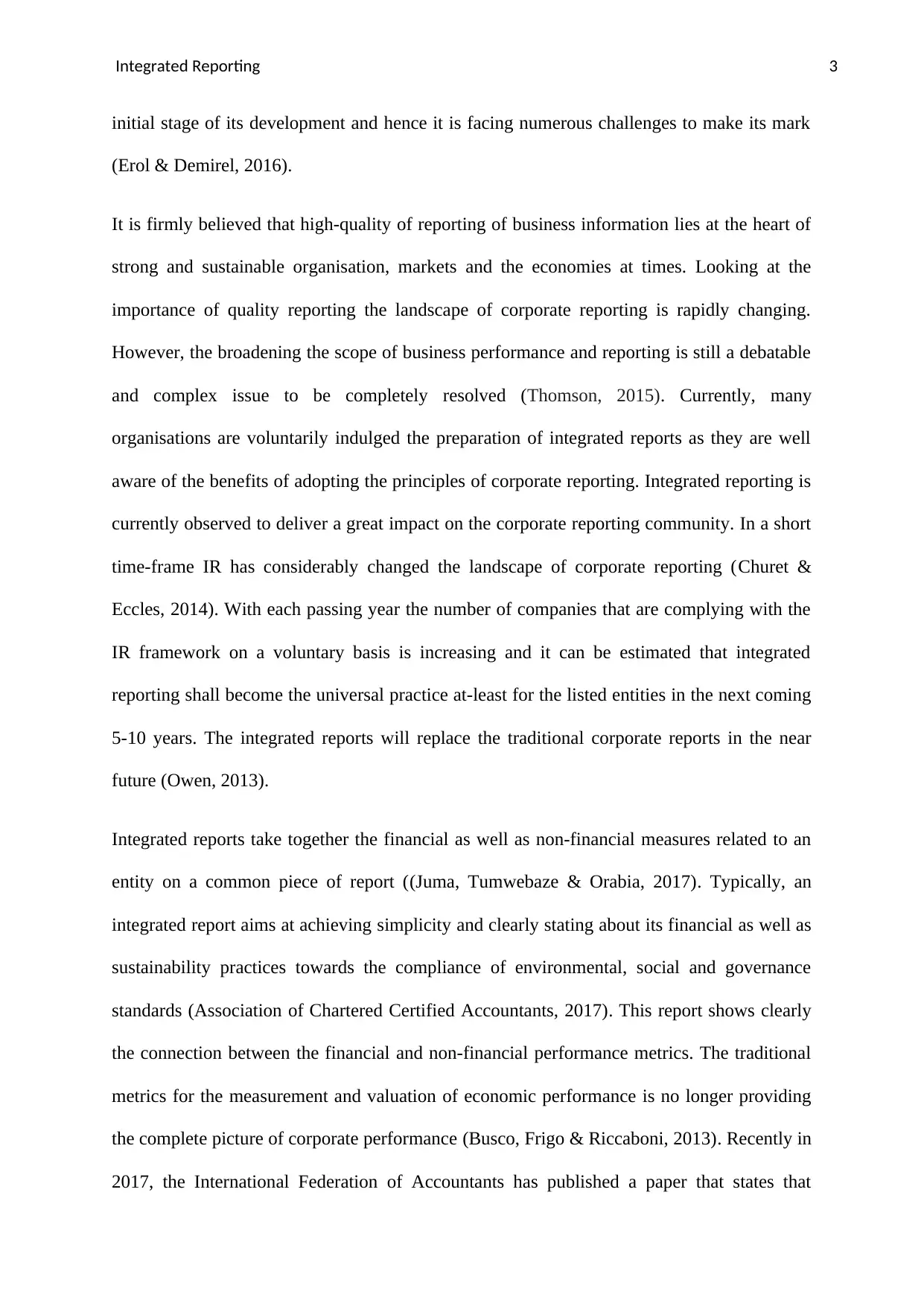
Integrated Reporting 3
initial stage of its development and hence it is facing numerous challenges to make its mark
(Erol & Demirel, 2016).
It is firmly believed that high-quality of reporting of business information lies at the heart of
strong and sustainable organisation, markets and the economies at times. Looking at the
importance of quality reporting the landscape of corporate reporting is rapidly changing.
However, the broadening the scope of business performance and reporting is still a debatable
and complex issue to be completely resolved (Thomson, 2015). Currently, many
organisations are voluntarily indulged the preparation of integrated reports as they are well
aware of the benefits of adopting the principles of corporate reporting. Integrated reporting is
currently observed to deliver a great impact on the corporate reporting community. In a short
time-frame IR has considerably changed the landscape of corporate reporting (Churet &
Eccles, 2014). With each passing year the number of companies that are complying with the
IR framework on a voluntary basis is increasing and it can be estimated that integrated
reporting shall become the universal practice at-least for the listed entities in the next coming
5-10 years. The integrated reports will replace the traditional corporate reports in the near
future (Owen, 2013).
Integrated reports take together the financial as well as non-financial measures related to an
entity on a common piece of report ((Juma, Tumwebaze & Orabia, 2017). Typically, an
integrated report aims at achieving simplicity and clearly stating about its financial as well as
sustainability practices towards the compliance of environmental, social and governance
standards (Association of Chartered Certified Accountants, 2017). This report shows clearly
the connection between the financial and non-financial performance metrics. The traditional
metrics for the measurement and valuation of economic performance is no longer providing
the complete picture of corporate performance (Busco, Frigo & Riccaboni, 2013). Recently in
2017, the International Federation of Accountants has published a paper that states that
initial stage of its development and hence it is facing numerous challenges to make its mark
(Erol & Demirel, 2016).
It is firmly believed that high-quality of reporting of business information lies at the heart of
strong and sustainable organisation, markets and the economies at times. Looking at the
importance of quality reporting the landscape of corporate reporting is rapidly changing.
However, the broadening the scope of business performance and reporting is still a debatable
and complex issue to be completely resolved (Thomson, 2015). Currently, many
organisations are voluntarily indulged the preparation of integrated reports as they are well
aware of the benefits of adopting the principles of corporate reporting. Integrated reporting is
currently observed to deliver a great impact on the corporate reporting community. In a short
time-frame IR has considerably changed the landscape of corporate reporting (Churet &
Eccles, 2014). With each passing year the number of companies that are complying with the
IR framework on a voluntary basis is increasing and it can be estimated that integrated
reporting shall become the universal practice at-least for the listed entities in the next coming
5-10 years. The integrated reports will replace the traditional corporate reports in the near
future (Owen, 2013).
Integrated reports take together the financial as well as non-financial measures related to an
entity on a common piece of report ((Juma, Tumwebaze & Orabia, 2017). Typically, an
integrated report aims at achieving simplicity and clearly stating about its financial as well as
sustainability practices towards the compliance of environmental, social and governance
standards (Association of Chartered Certified Accountants, 2017). This report shows clearly
the connection between the financial and non-financial performance metrics. The traditional
metrics for the measurement and valuation of economic performance is no longer providing
the complete picture of corporate performance (Busco, Frigo & Riccaboni, 2013). Recently in
2017, the International Federation of Accountants has published a paper that states that
Secure Best Marks with AI Grader
Need help grading? Try our AI Grader for instant feedback on your assignments.
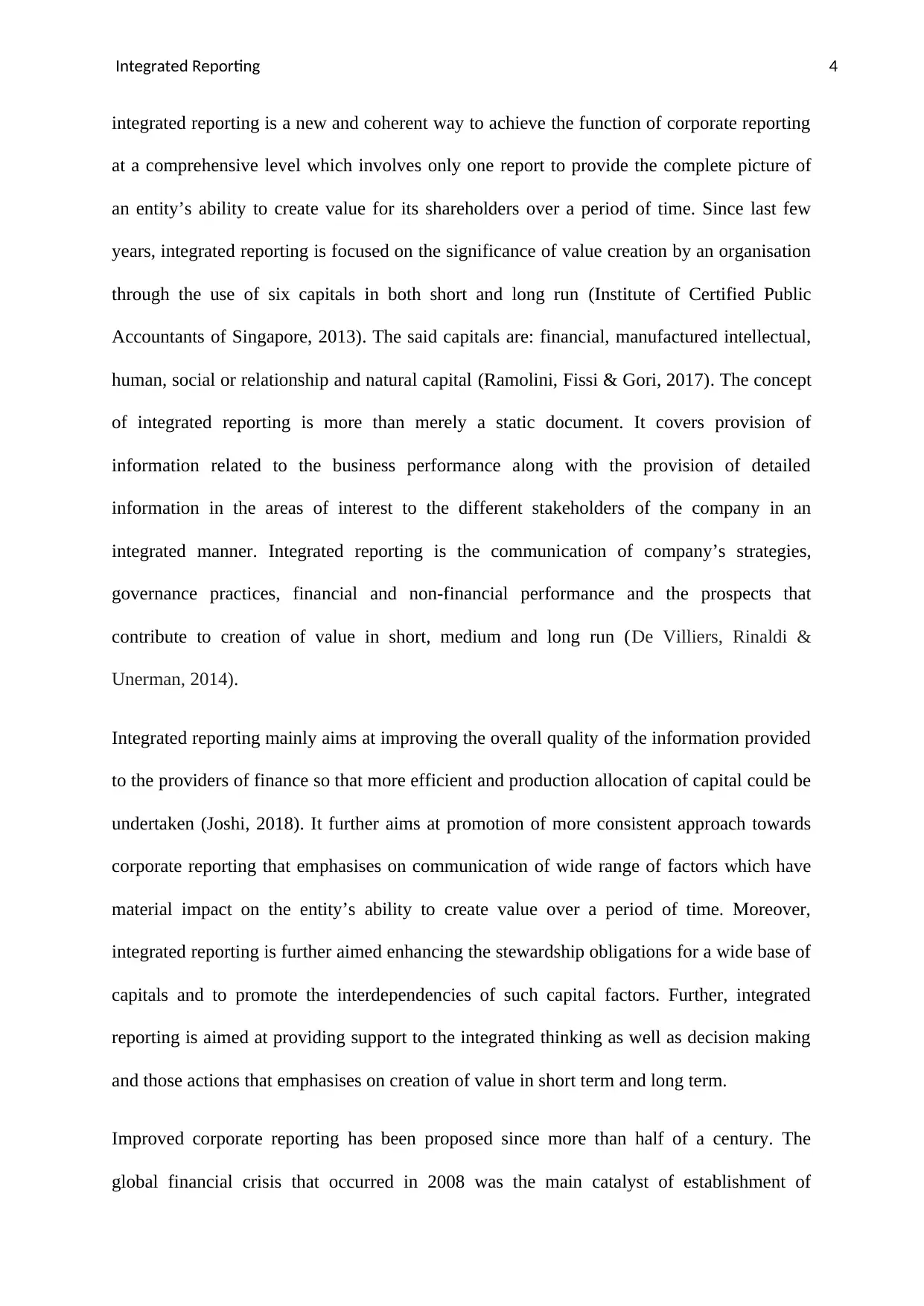
Integrated Reporting 4
integrated reporting is a new and coherent way to achieve the function of corporate reporting
at a comprehensive level which involves only one report to provide the complete picture of
an entity’s ability to create value for its shareholders over a period of time. Since last few
years, integrated reporting is focused on the significance of value creation by an organisation
through the use of six capitals in both short and long run (Institute of Certified Public
Accountants of Singapore, 2013). The said capitals are: financial, manufactured intellectual,
human, social or relationship and natural capital (Ramolini, Fissi & Gori, 2017). The concept
of integrated reporting is more than merely a static document. It covers provision of
information related to the business performance along with the provision of detailed
information in the areas of interest to the different stakeholders of the company in an
integrated manner. Integrated reporting is the communication of company’s strategies,
governance practices, financial and non-financial performance and the prospects that
contribute to creation of value in short, medium and long run (De Villiers, Rinaldi &
Unerman, 2014).
Integrated reporting mainly aims at improving the overall quality of the information provided
to the providers of finance so that more efficient and production allocation of capital could be
undertaken (Joshi, 2018). It further aims at promotion of more consistent approach towards
corporate reporting that emphasises on communication of wide range of factors which have
material impact on the entity’s ability to create value over a period of time. Moreover,
integrated reporting is further aimed enhancing the stewardship obligations for a wide base of
capitals and to promote the interdependencies of such capital factors. Further, integrated
reporting is aimed at providing support to the integrated thinking as well as decision making
and those actions that emphasises on creation of value in short term and long term.
Improved corporate reporting has been proposed since more than half of a century. The
global financial crisis that occurred in 2008 was the main catalyst of establishment of
integrated reporting is a new and coherent way to achieve the function of corporate reporting
at a comprehensive level which involves only one report to provide the complete picture of
an entity’s ability to create value for its shareholders over a period of time. Since last few
years, integrated reporting is focused on the significance of value creation by an organisation
through the use of six capitals in both short and long run (Institute of Certified Public
Accountants of Singapore, 2013). The said capitals are: financial, manufactured intellectual,
human, social or relationship and natural capital (Ramolini, Fissi & Gori, 2017). The concept
of integrated reporting is more than merely a static document. It covers provision of
information related to the business performance along with the provision of detailed
information in the areas of interest to the different stakeholders of the company in an
integrated manner. Integrated reporting is the communication of company’s strategies,
governance practices, financial and non-financial performance and the prospects that
contribute to creation of value in short, medium and long run (De Villiers, Rinaldi &
Unerman, 2014).
Integrated reporting mainly aims at improving the overall quality of the information provided
to the providers of finance so that more efficient and production allocation of capital could be
undertaken (Joshi, 2018). It further aims at promotion of more consistent approach towards
corporate reporting that emphasises on communication of wide range of factors which have
material impact on the entity’s ability to create value over a period of time. Moreover,
integrated reporting is further aimed enhancing the stewardship obligations for a wide base of
capitals and to promote the interdependencies of such capital factors. Further, integrated
reporting is aimed at providing support to the integrated thinking as well as decision making
and those actions that emphasises on creation of value in short term and long term.
Improved corporate reporting has been proposed since more than half of a century. The
global financial crisis that occurred in 2008 was the main catalyst of establishment of
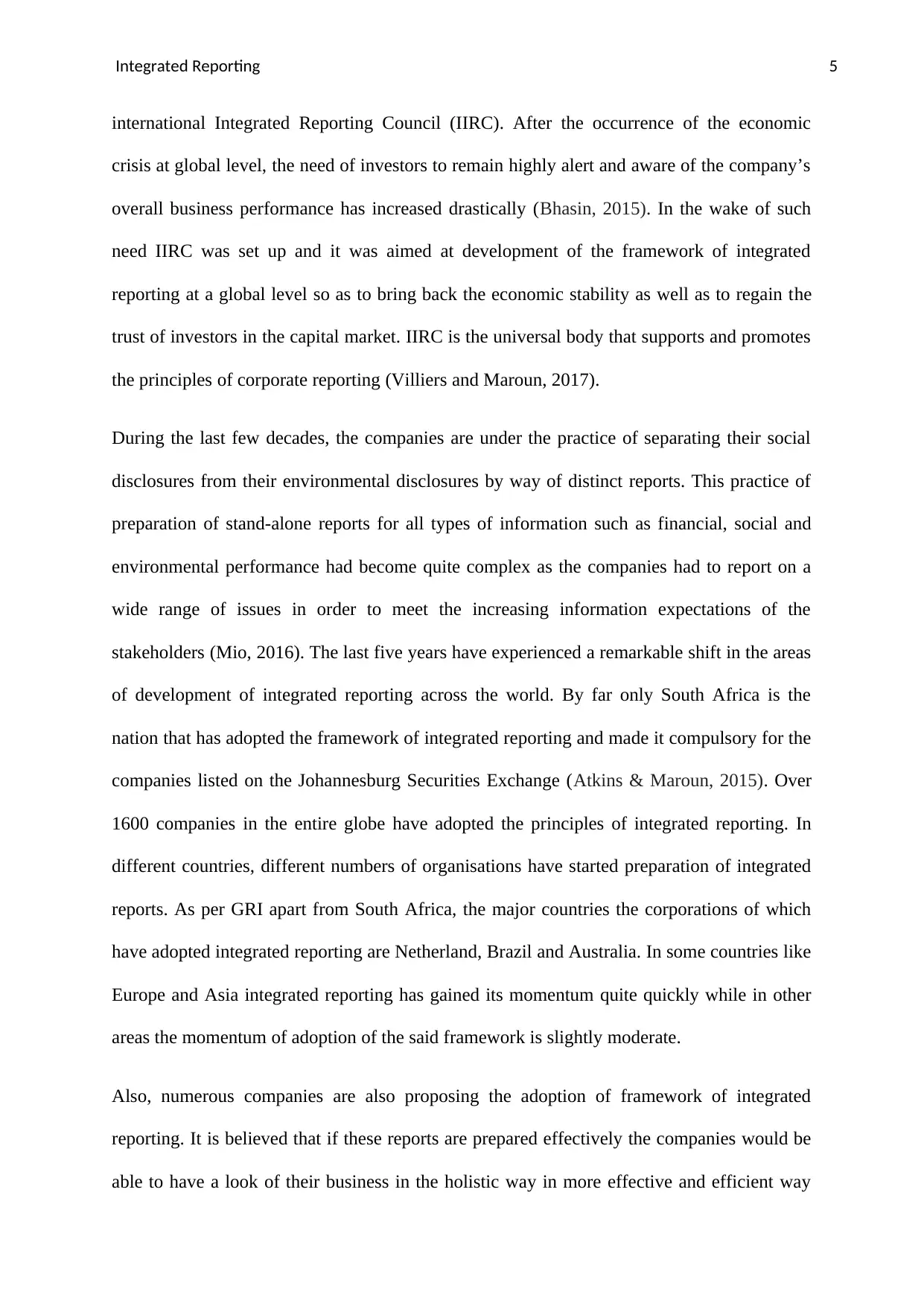
Integrated Reporting 5
international Integrated Reporting Council (IIRC). After the occurrence of the economic
crisis at global level, the need of investors to remain highly alert and aware of the company’s
overall business performance has increased drastically (Bhasin, 2015). In the wake of such
need IIRC was set up and it was aimed at development of the framework of integrated
reporting at a global level so as to bring back the economic stability as well as to regain the
trust of investors in the capital market. IIRC is the universal body that supports and promotes
the principles of corporate reporting (Villiers and Maroun, 2017).
During the last few decades, the companies are under the practice of separating their social
disclosures from their environmental disclosures by way of distinct reports. This practice of
preparation of stand-alone reports for all types of information such as financial, social and
environmental performance had become quite complex as the companies had to report on a
wide range of issues in order to meet the increasing information expectations of the
stakeholders (Mio, 2016). The last five years have experienced a remarkable shift in the areas
of development of integrated reporting across the world. By far only South Africa is the
nation that has adopted the framework of integrated reporting and made it compulsory for the
companies listed on the Johannesburg Securities Exchange (Atkins & Maroun, 2015). Over
1600 companies in the entire globe have adopted the principles of integrated reporting. In
different countries, different numbers of organisations have started preparation of integrated
reports. As per GRI apart from South Africa, the major countries the corporations of which
have adopted integrated reporting are Netherland, Brazil and Australia. In some countries like
Europe and Asia integrated reporting has gained its momentum quite quickly while in other
areas the momentum of adoption of the said framework is slightly moderate.
Also, numerous companies are also proposing the adoption of framework of integrated
reporting. It is believed that if these reports are prepared effectively the companies would be
able to have a look of their business in the holistic way in more effective and efficient way
international Integrated Reporting Council (IIRC). After the occurrence of the economic
crisis at global level, the need of investors to remain highly alert and aware of the company’s
overall business performance has increased drastically (Bhasin, 2015). In the wake of such
need IIRC was set up and it was aimed at development of the framework of integrated
reporting at a global level so as to bring back the economic stability as well as to regain the
trust of investors in the capital market. IIRC is the universal body that supports and promotes
the principles of corporate reporting (Villiers and Maroun, 2017).
During the last few decades, the companies are under the practice of separating their social
disclosures from their environmental disclosures by way of distinct reports. This practice of
preparation of stand-alone reports for all types of information such as financial, social and
environmental performance had become quite complex as the companies had to report on a
wide range of issues in order to meet the increasing information expectations of the
stakeholders (Mio, 2016). The last five years have experienced a remarkable shift in the areas
of development of integrated reporting across the world. By far only South Africa is the
nation that has adopted the framework of integrated reporting and made it compulsory for the
companies listed on the Johannesburg Securities Exchange (Atkins & Maroun, 2015). Over
1600 companies in the entire globe have adopted the principles of integrated reporting. In
different countries, different numbers of organisations have started preparation of integrated
reports. As per GRI apart from South Africa, the major countries the corporations of which
have adopted integrated reporting are Netherland, Brazil and Australia. In some countries like
Europe and Asia integrated reporting has gained its momentum quite quickly while in other
areas the momentum of adoption of the said framework is slightly moderate.
Also, numerous companies are also proposing the adoption of framework of integrated
reporting. It is believed that if these reports are prepared effectively the companies would be
able to have a look of their business in the holistic way in more effective and efficient way
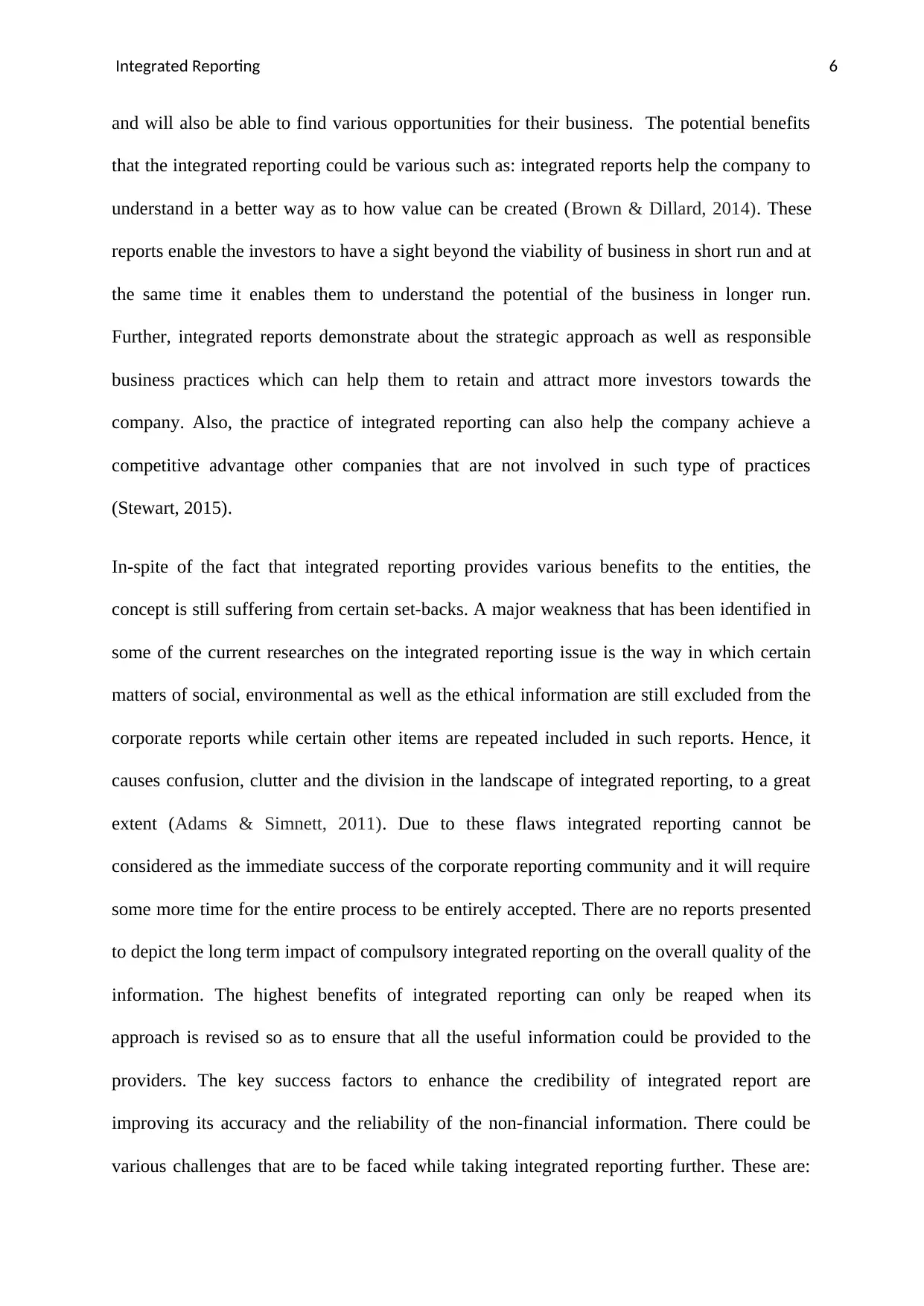
Integrated Reporting 6
and will also be able to find various opportunities for their business. The potential benefits
that the integrated reporting could be various such as: integrated reports help the company to
understand in a better way as to how value can be created (Brown & Dillard, 2014). These
reports enable the investors to have a sight beyond the viability of business in short run and at
the same time it enables them to understand the potential of the business in longer run.
Further, integrated reports demonstrate about the strategic approach as well as responsible
business practices which can help them to retain and attract more investors towards the
company. Also, the practice of integrated reporting can also help the company achieve a
competitive advantage other companies that are not involved in such type of practices
(Stewart, 2015).
In-spite of the fact that integrated reporting provides various benefits to the entities, the
concept is still suffering from certain set-backs. A major weakness that has been identified in
some of the current researches on the integrated reporting issue is the way in which certain
matters of social, environmental as well as the ethical information are still excluded from the
corporate reports while certain other items are repeated included in such reports. Hence, it
causes confusion, clutter and the division in the landscape of integrated reporting, to a great
extent (Adams & Simnett, 2011). Due to these flaws integrated reporting cannot be
considered as the immediate success of the corporate reporting community and it will require
some more time for the entire process to be entirely accepted. There are no reports presented
to depict the long term impact of compulsory integrated reporting on the overall quality of the
information. The highest benefits of integrated reporting can only be reaped when its
approach is revised so as to ensure that all the useful information could be provided to the
providers. The key success factors to enhance the credibility of integrated report are
improving its accuracy and the reliability of the non-financial information. There could be
various challenges that are to be faced while taking integrated reporting further. These are:
and will also be able to find various opportunities for their business. The potential benefits
that the integrated reporting could be various such as: integrated reports help the company to
understand in a better way as to how value can be created (Brown & Dillard, 2014). These
reports enable the investors to have a sight beyond the viability of business in short run and at
the same time it enables them to understand the potential of the business in longer run.
Further, integrated reports demonstrate about the strategic approach as well as responsible
business practices which can help them to retain and attract more investors towards the
company. Also, the practice of integrated reporting can also help the company achieve a
competitive advantage other companies that are not involved in such type of practices
(Stewart, 2015).
In-spite of the fact that integrated reporting provides various benefits to the entities, the
concept is still suffering from certain set-backs. A major weakness that has been identified in
some of the current researches on the integrated reporting issue is the way in which certain
matters of social, environmental as well as the ethical information are still excluded from the
corporate reports while certain other items are repeated included in such reports. Hence, it
causes confusion, clutter and the division in the landscape of integrated reporting, to a great
extent (Adams & Simnett, 2011). Due to these flaws integrated reporting cannot be
considered as the immediate success of the corporate reporting community and it will require
some more time for the entire process to be entirely accepted. There are no reports presented
to depict the long term impact of compulsory integrated reporting on the overall quality of the
information. The highest benefits of integrated reporting can only be reaped when its
approach is revised so as to ensure that all the useful information could be provided to the
providers. The key success factors to enhance the credibility of integrated report are
improving its accuracy and the reliability of the non-financial information. There could be
various challenges that are to be faced while taking integrated reporting further. These are:
Paraphrase This Document
Need a fresh take? Get an instant paraphrase of this document with our AI Paraphraser
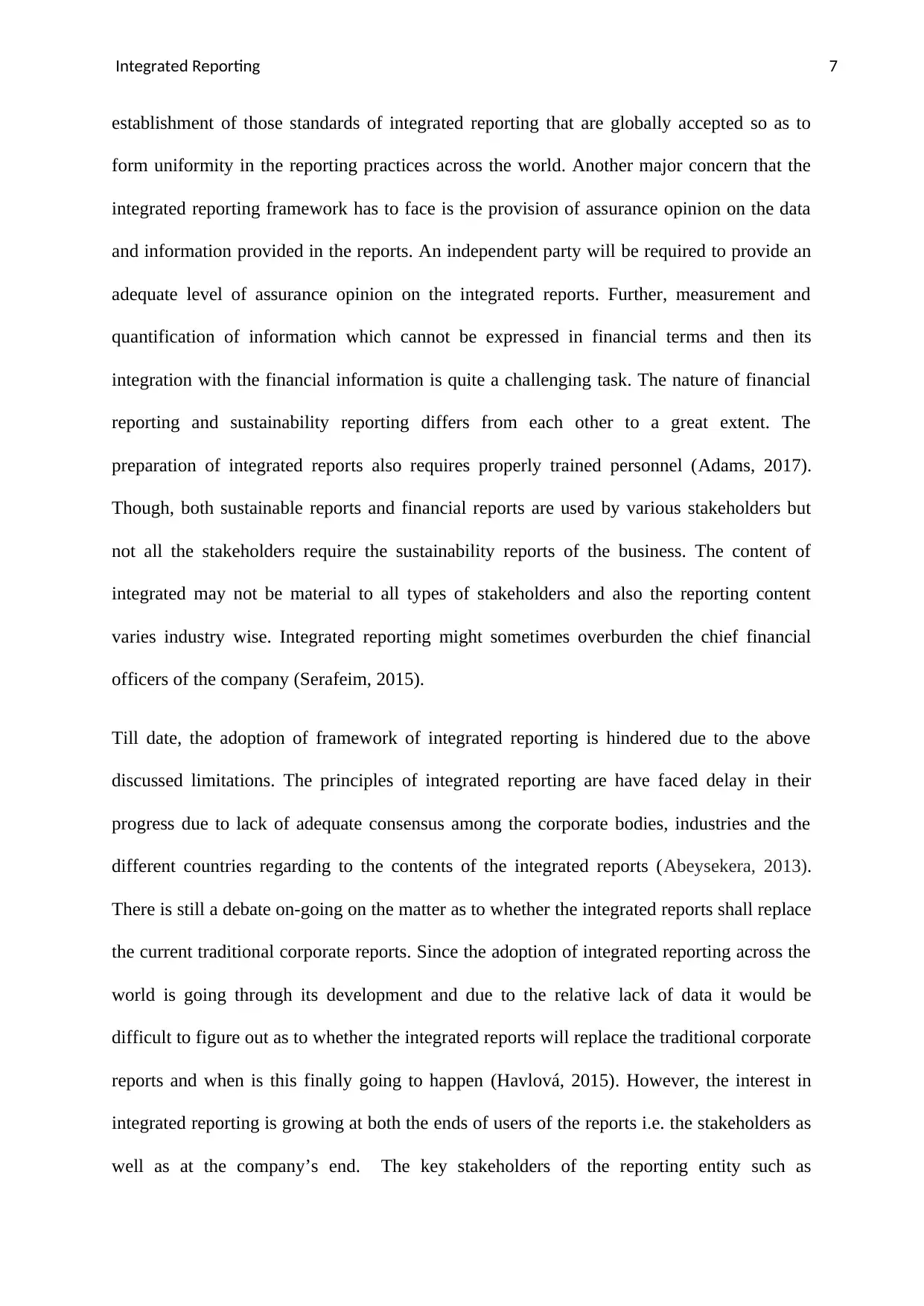
Integrated Reporting 7
establishment of those standards of integrated reporting that are globally accepted so as to
form uniformity in the reporting practices across the world. Another major concern that the
integrated reporting framework has to face is the provision of assurance opinion on the data
and information provided in the reports. An independent party will be required to provide an
adequate level of assurance opinion on the integrated reports. Further, measurement and
quantification of information which cannot be expressed in financial terms and then its
integration with the financial information is quite a challenging task. The nature of financial
reporting and sustainability reporting differs from each other to a great extent. The
preparation of integrated reports also requires properly trained personnel (Adams, 2017).
Though, both sustainable reports and financial reports are used by various stakeholders but
not all the stakeholders require the sustainability reports of the business. The content of
integrated may not be material to all types of stakeholders and also the reporting content
varies industry wise. Integrated reporting might sometimes overburden the chief financial
officers of the company (Serafeim, 2015).
Till date, the adoption of framework of integrated reporting is hindered due to the above
discussed limitations. The principles of integrated reporting are have faced delay in their
progress due to lack of adequate consensus among the corporate bodies, industries and the
different countries regarding to the contents of the integrated reports (Abeysekera, 2013).
There is still a debate on-going on the matter as to whether the integrated reports shall replace
the current traditional corporate reports. Since the adoption of integrated reporting across the
world is going through its development and due to the relative lack of data it would be
difficult to figure out as to whether the integrated reports will replace the traditional corporate
reports and when is this finally going to happen (Havlová, 2015). However, the interest in
integrated reporting is growing at both the ends of users of the reports i.e. the stakeholders as
well as at the company’s end. The key stakeholders of the reporting entity such as
establishment of those standards of integrated reporting that are globally accepted so as to
form uniformity in the reporting practices across the world. Another major concern that the
integrated reporting framework has to face is the provision of assurance opinion on the data
and information provided in the reports. An independent party will be required to provide an
adequate level of assurance opinion on the integrated reports. Further, measurement and
quantification of information which cannot be expressed in financial terms and then its
integration with the financial information is quite a challenging task. The nature of financial
reporting and sustainability reporting differs from each other to a great extent. The
preparation of integrated reports also requires properly trained personnel (Adams, 2017).
Though, both sustainable reports and financial reports are used by various stakeholders but
not all the stakeholders require the sustainability reports of the business. The content of
integrated may not be material to all types of stakeholders and also the reporting content
varies industry wise. Integrated reporting might sometimes overburden the chief financial
officers of the company (Serafeim, 2015).
Till date, the adoption of framework of integrated reporting is hindered due to the above
discussed limitations. The principles of integrated reporting are have faced delay in their
progress due to lack of adequate consensus among the corporate bodies, industries and the
different countries regarding to the contents of the integrated reports (Abeysekera, 2013).
There is still a debate on-going on the matter as to whether the integrated reports shall replace
the current traditional corporate reports. Since the adoption of integrated reporting across the
world is going through its development and due to the relative lack of data it would be
difficult to figure out as to whether the integrated reports will replace the traditional corporate
reports and when is this finally going to happen (Havlová, 2015). However, the interest in
integrated reporting is growing at both the ends of users of the reports i.e. the stakeholders as
well as at the company’s end. The key stakeholders of the reporting entity such as
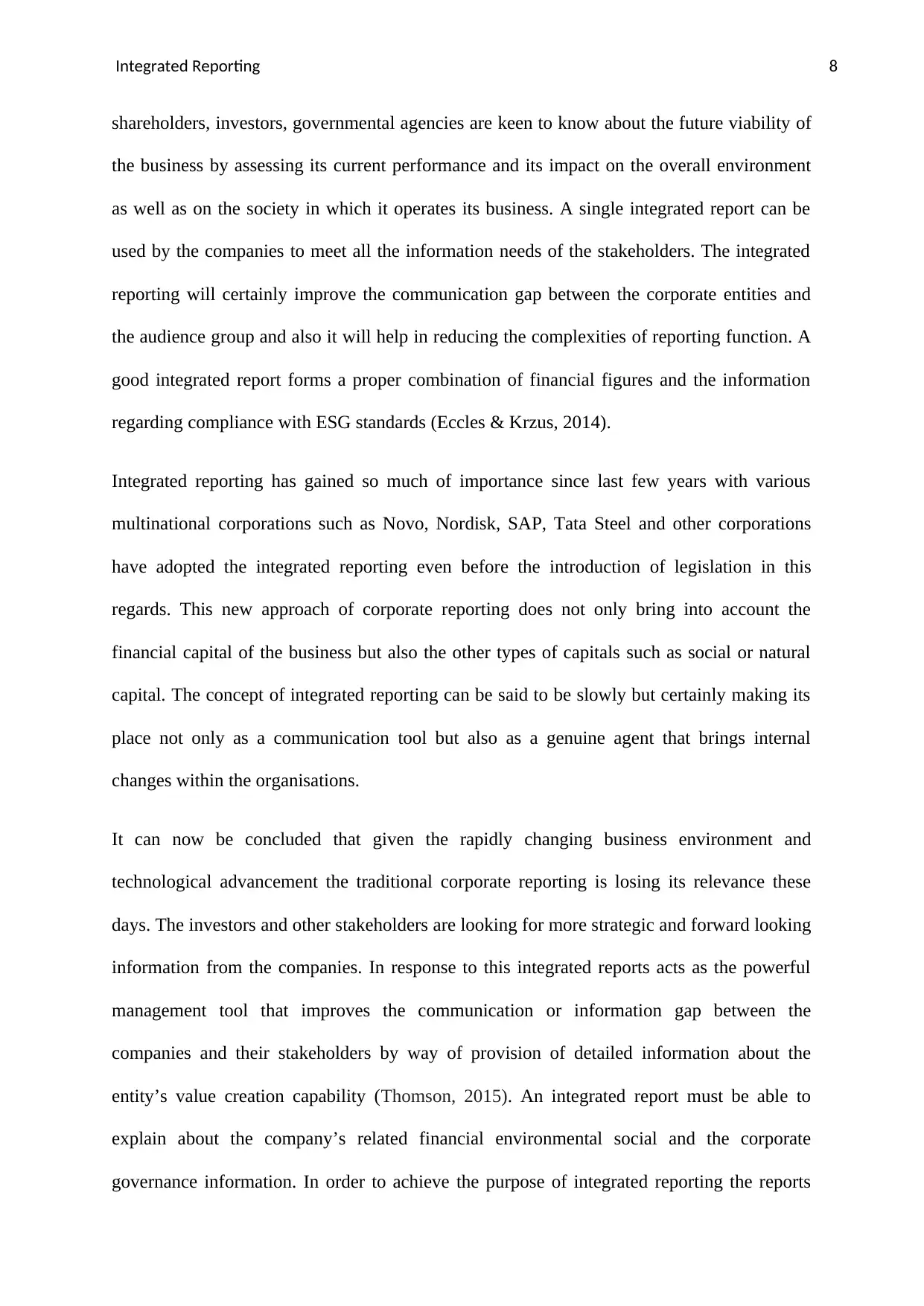
Integrated Reporting 8
shareholders, investors, governmental agencies are keen to know about the future viability of
the business by assessing its current performance and its impact on the overall environment
as well as on the society in which it operates its business. A single integrated report can be
used by the companies to meet all the information needs of the stakeholders. The integrated
reporting will certainly improve the communication gap between the corporate entities and
the audience group and also it will help in reducing the complexities of reporting function. A
good integrated report forms a proper combination of financial figures and the information
regarding compliance with ESG standards (Eccles & Krzus, 2014).
Integrated reporting has gained so much of importance since last few years with various
multinational corporations such as Novo, Nordisk, SAP, Tata Steel and other corporations
have adopted the integrated reporting even before the introduction of legislation in this
regards. This new approach of corporate reporting does not only bring into account the
financial capital of the business but also the other types of capitals such as social or natural
capital. The concept of integrated reporting can be said to be slowly but certainly making its
place not only as a communication tool but also as a genuine agent that brings internal
changes within the organisations.
It can now be concluded that given the rapidly changing business environment and
technological advancement the traditional corporate reporting is losing its relevance these
days. The investors and other stakeholders are looking for more strategic and forward looking
information from the companies. In response to this integrated reports acts as the powerful
management tool that improves the communication or information gap between the
companies and their stakeholders by way of provision of detailed information about the
entity’s value creation capability (Thomson, 2015). An integrated report must be able to
explain about the company’s related financial environmental social and the corporate
governance information. In order to achieve the purpose of integrated reporting the reports
shareholders, investors, governmental agencies are keen to know about the future viability of
the business by assessing its current performance and its impact on the overall environment
as well as on the society in which it operates its business. A single integrated report can be
used by the companies to meet all the information needs of the stakeholders. The integrated
reporting will certainly improve the communication gap between the corporate entities and
the audience group and also it will help in reducing the complexities of reporting function. A
good integrated report forms a proper combination of financial figures and the information
regarding compliance with ESG standards (Eccles & Krzus, 2014).
Integrated reporting has gained so much of importance since last few years with various
multinational corporations such as Novo, Nordisk, SAP, Tata Steel and other corporations
have adopted the integrated reporting even before the introduction of legislation in this
regards. This new approach of corporate reporting does not only bring into account the
financial capital of the business but also the other types of capitals such as social or natural
capital. The concept of integrated reporting can be said to be slowly but certainly making its
place not only as a communication tool but also as a genuine agent that brings internal
changes within the organisations.
It can now be concluded that given the rapidly changing business environment and
technological advancement the traditional corporate reporting is losing its relevance these
days. The investors and other stakeholders are looking for more strategic and forward looking
information from the companies. In response to this integrated reports acts as the powerful
management tool that improves the communication or information gap between the
companies and their stakeholders by way of provision of detailed information about the
entity’s value creation capability (Thomson, 2015). An integrated report must be able to
explain about the company’s related financial environmental social and the corporate
governance information. In order to achieve the purpose of integrated reporting the reports

Integrated Reporting 9
must be presented in the clear concise and consistent manner. The adoption of principles of
integrated reporting could ultimately increase the capacity of the reporting entity to assess
more capital as it creates a positive market image in the eyes of investors in the capital
market. Though, it is correct that financial reports plays vital role in satisfying the
stakeholders of the company about their information needs but it is also true that merely
financial reports cannot achieve the basic purpose of corporate reporting. A company must
also report about its sustainable business practices so as to deal with the growing information
needs of the user group of corporate reports. The main agenda behind the corporate reporting
is not only to provide the detailed information but also the quality information. Integrated
reports must include all the possible information that the stakeholders of the company are
seeking. As of now only few multinational corporations are indulged in the practices of
integrated reporting. The provisions related to such framework are not yet made compulsory
in majority of countries. But, since integrated reporting brings various benefits for the
companies and those benefits of preparing integrated reports certainly exceeds the cost of
adoption of integrated reporting principles, the integrated reporting must be made a
mandatory management practice in the coming years. This initiative will bring a great impact
to the efficiency of capital markets as the potential investors will be able to make sound
decisions regarding the allocation of their capital resources after evaluating the overall
business performance from both financial and non-financial parameters.
must be presented in the clear concise and consistent manner. The adoption of principles of
integrated reporting could ultimately increase the capacity of the reporting entity to assess
more capital as it creates a positive market image in the eyes of investors in the capital
market. Though, it is correct that financial reports plays vital role in satisfying the
stakeholders of the company about their information needs but it is also true that merely
financial reports cannot achieve the basic purpose of corporate reporting. A company must
also report about its sustainable business practices so as to deal with the growing information
needs of the user group of corporate reports. The main agenda behind the corporate reporting
is not only to provide the detailed information but also the quality information. Integrated
reports must include all the possible information that the stakeholders of the company are
seeking. As of now only few multinational corporations are indulged in the practices of
integrated reporting. The provisions related to such framework are not yet made compulsory
in majority of countries. But, since integrated reporting brings various benefits for the
companies and those benefits of preparing integrated reports certainly exceeds the cost of
adoption of integrated reporting principles, the integrated reporting must be made a
mandatory management practice in the coming years. This initiative will bring a great impact
to the efficiency of capital markets as the potential investors will be able to make sound
decisions regarding the allocation of their capital resources after evaluating the overall
business performance from both financial and non-financial parameters.
Secure Best Marks with AI Grader
Need help grading? Try our AI Grader for instant feedback on your assignments.
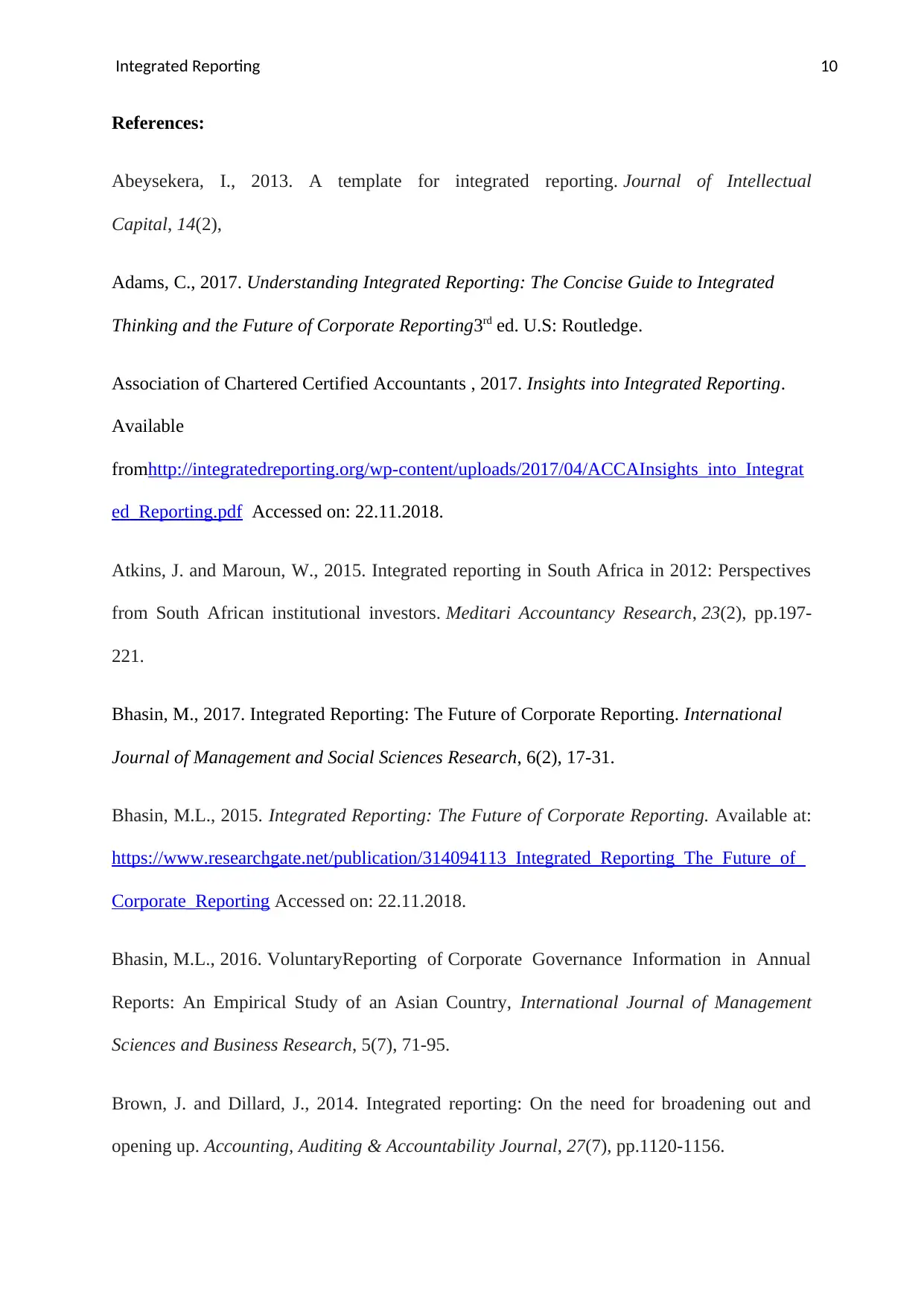
Integrated Reporting 10
References:
Abeysekera, I., 2013. A template for integrated reporting. Journal of Intellectual
Capital, 14(2),
Adams, C., 2017. Understanding Integrated Reporting: The Concise Guide to Integrated
Thinking and the Future of Corporate Reporting3rd ed. U.S: Routledge.
Association of Chartered Certified Accountants , 2017. Insights into Integrated Reporting.
Available
fromhttp://integratedreporting.org/wp-content/uploads/2017/04/ACCAInsights_into_Integrat
ed_Reporting.pdf Accessed on: 22.11.2018.
Atkins, J. and Maroun, W., 2015. Integrated reporting in South Africa in 2012: Perspectives
from South African institutional investors. Meditari Accountancy Research, 23(2), pp.197-
221.
Bhasin, M., 2017. Integrated Reporting: The Future of Corporate Reporting. International
Journal of Management and Social Sciences Research, 6(2), 17-31.
Bhasin, M.L., 2015. Integrated Reporting: The Future of Corporate Reporting. Available at:
https://www.researchgate.net/publication/314094113_Integrated_Reporting_The_Future_of_
Corporate_Reporting Accessed on: 22.11.2018.
Bhasin, M.L., 2016. VoluntaryReporting of Corporate Governance Information in Annual
Reports: An Empirical Study of an Asian Country, International Journal of Management
Sciences and Business Research, 5(7), 71-95.
Brown, J. and Dillard, J., 2014. Integrated reporting: On the need for broadening out and
opening up. Accounting, Auditing & Accountability Journal, 27(7), pp.1120-1156.
References:
Abeysekera, I., 2013. A template for integrated reporting. Journal of Intellectual
Capital, 14(2),
Adams, C., 2017. Understanding Integrated Reporting: The Concise Guide to Integrated
Thinking and the Future of Corporate Reporting3rd ed. U.S: Routledge.
Association of Chartered Certified Accountants , 2017. Insights into Integrated Reporting.
Available
fromhttp://integratedreporting.org/wp-content/uploads/2017/04/ACCAInsights_into_Integrat
ed_Reporting.pdf Accessed on: 22.11.2018.
Atkins, J. and Maroun, W., 2015. Integrated reporting in South Africa in 2012: Perspectives
from South African institutional investors. Meditari Accountancy Research, 23(2), pp.197-
221.
Bhasin, M., 2017. Integrated Reporting: The Future of Corporate Reporting. International
Journal of Management and Social Sciences Research, 6(2), 17-31.
Bhasin, M.L., 2015. Integrated Reporting: The Future of Corporate Reporting. Available at:
https://www.researchgate.net/publication/314094113_Integrated_Reporting_The_Future_of_
Corporate_Reporting Accessed on: 22.11.2018.
Bhasin, M.L., 2016. VoluntaryReporting of Corporate Governance Information in Annual
Reports: An Empirical Study of an Asian Country, International Journal of Management
Sciences and Business Research, 5(7), 71-95.
Brown, J. and Dillard, J., 2014. Integrated reporting: On the need for broadening out and
opening up. Accounting, Auditing & Accountability Journal, 27(7), pp.1120-1156.
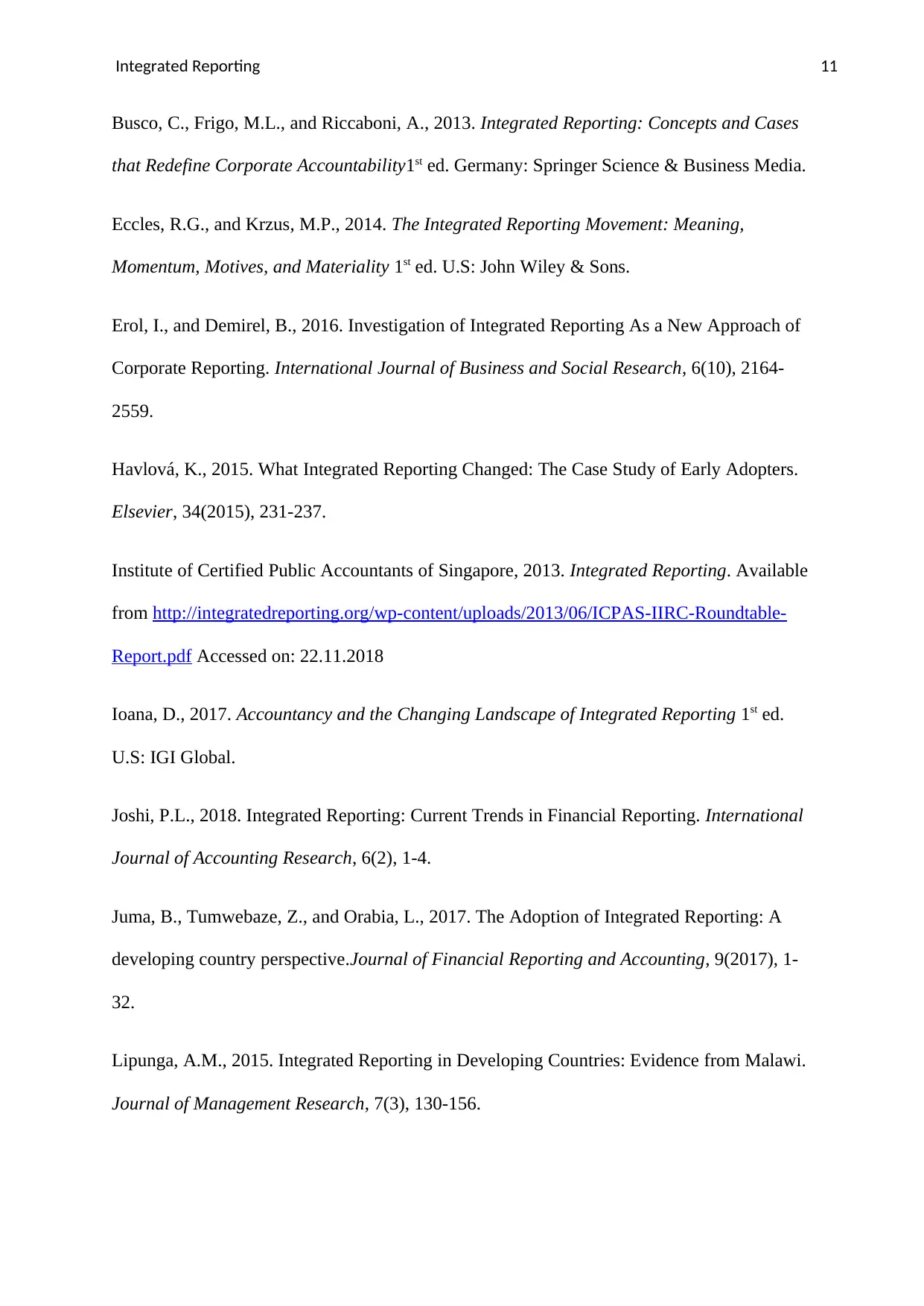
Integrated Reporting 11
Busco, C., Frigo, M.L., and Riccaboni, A., 2013. Integrated Reporting: Concepts and Cases
that Redefine Corporate Accountability1st ed. Germany: Springer Science & Business Media.
Eccles, R.G., and Krzus, M.P., 2014. The Integrated Reporting Movement: Meaning,
Momentum, Motives, and Materiality 1st ed. U.S: John Wiley & Sons.
Erol, I., and Demirel, B., 2016. Investigation of Integrated Reporting As a New Approach of
Corporate Reporting. International Journal of Business and Social Research, 6(10), 2164-
2559.
Havlová, K., 2015. What Integrated Reporting Changed: The Case Study of Early Adopters.
Elsevier, 34(2015), 231-237.
Institute of Certified Public Accountants of Singapore, 2013. Integrated Reporting. Available
from http://integratedreporting.org/wp-content/uploads/2013/06/ICPAS-IIRC-Roundtable-
Report.pdf Accessed on: 22.11.2018
Ioana, D., 2017. Accountancy and the Changing Landscape of Integrated Reporting 1st ed.
U.S: IGI Global.
Joshi, P.L., 2018. Integrated Reporting: Current Trends in Financial Reporting. International
Journal of Accounting Research, 6(2), 1-4.
Juma, B., Tumwebaze, Z., and Orabia, L., 2017. The Adoption of Integrated Reporting: A
developing country perspective.Journal of Financial Reporting and Accounting, 9(2017), 1-
32.
Lipunga, A.M., 2015. Integrated Reporting in Developing Countries: Evidence from Malawi.
Journal of Management Research, 7(3), 130-156.
Busco, C., Frigo, M.L., and Riccaboni, A., 2013. Integrated Reporting: Concepts and Cases
that Redefine Corporate Accountability1st ed. Germany: Springer Science & Business Media.
Eccles, R.G., and Krzus, M.P., 2014. The Integrated Reporting Movement: Meaning,
Momentum, Motives, and Materiality 1st ed. U.S: John Wiley & Sons.
Erol, I., and Demirel, B., 2016. Investigation of Integrated Reporting As a New Approach of
Corporate Reporting. International Journal of Business and Social Research, 6(10), 2164-
2559.
Havlová, K., 2015. What Integrated Reporting Changed: The Case Study of Early Adopters.
Elsevier, 34(2015), 231-237.
Institute of Certified Public Accountants of Singapore, 2013. Integrated Reporting. Available
from http://integratedreporting.org/wp-content/uploads/2013/06/ICPAS-IIRC-Roundtable-
Report.pdf Accessed on: 22.11.2018
Ioana, D., 2017. Accountancy and the Changing Landscape of Integrated Reporting 1st ed.
U.S: IGI Global.
Joshi, P.L., 2018. Integrated Reporting: Current Trends in Financial Reporting. International
Journal of Accounting Research, 6(2), 1-4.
Juma, B., Tumwebaze, Z., and Orabia, L., 2017. The Adoption of Integrated Reporting: A
developing country perspective.Journal of Financial Reporting and Accounting, 9(2017), 1-
32.
Lipunga, A.M., 2015. Integrated Reporting in Developing Countries: Evidence from Malawi.
Journal of Management Research, 7(3), 130-156.
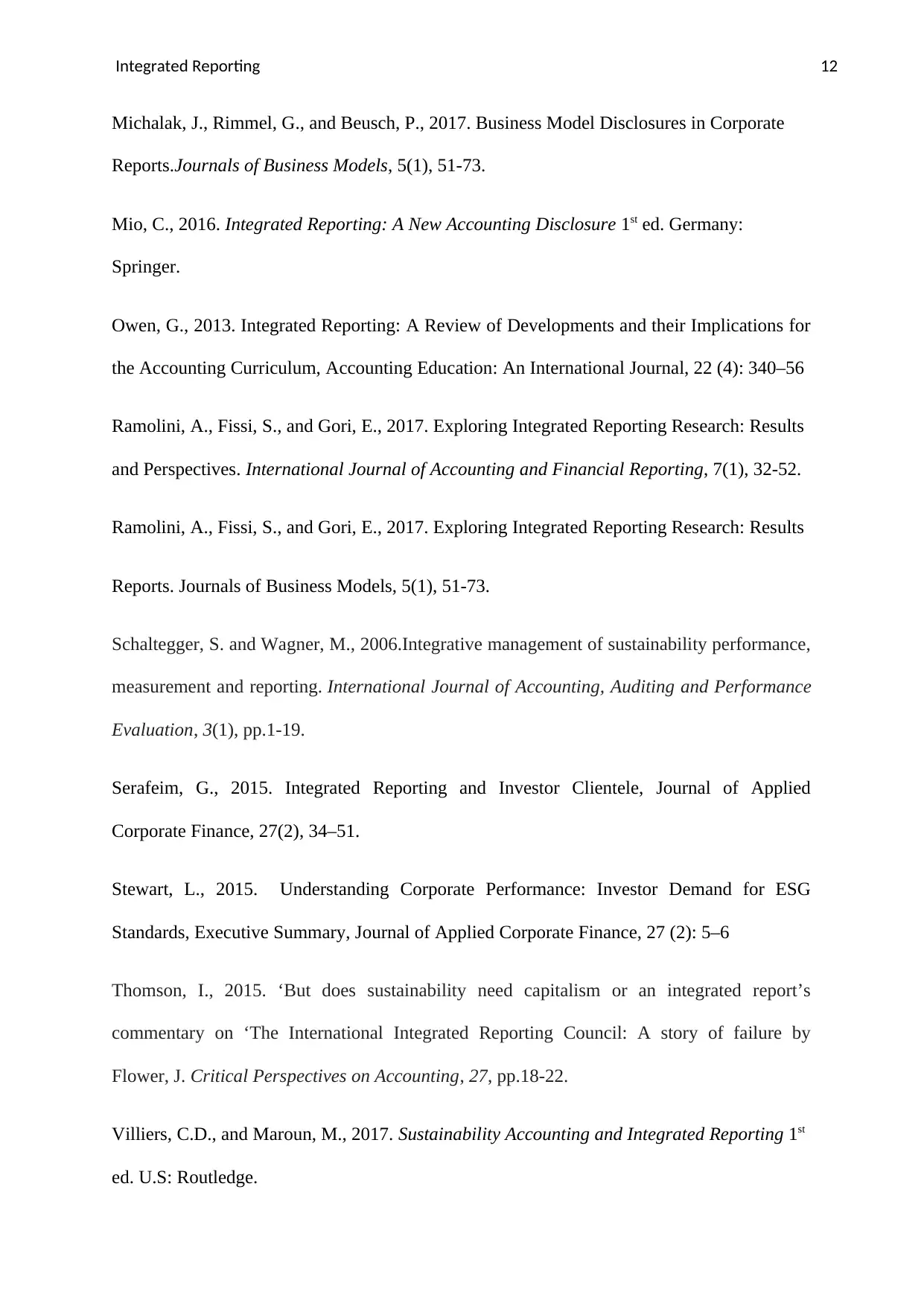
Integrated Reporting 12
Michalak, J., Rimmel, G., and Beusch, P., 2017. Business Model Disclosures in Corporate
Reports.Journals of Business Models, 5(1), 51-73.
Mio, C., 2016. Integrated Reporting: A New Accounting Disclosure 1st ed. Germany:
Springer.
Owen, G., 2013. Integrated Reporting: A Review of Developments and their Implications for
the Accounting Curriculum, Accounting Education: An International Journal, 22 (4): 340–56
Ramolini, A., Fissi, S., and Gori, E., 2017. Exploring Integrated Reporting Research: Results
and Perspectives. International Journal of Accounting and Financial Reporting, 7(1), 32-52.
Ramolini, A., Fissi, S., and Gori, E., 2017. Exploring Integrated Reporting Research: Results
Reports. Journals of Business Models, 5(1), 51-73.
Schaltegger, S. and Wagner, M., 2006.Integrative management of sustainability performance,
measurement and reporting. International Journal of Accounting, Auditing and Performance
Evaluation, 3(1), pp.1-19.
Serafeim, G., 2015. Integrated Reporting and Investor Clientele, Journal of Applied
Corporate Finance, 27(2), 34–51.
Stewart, L., 2015. Understanding Corporate Performance: Investor Demand for ESG
Standards, Executive Summary, Journal of Applied Corporate Finance, 27 (2): 5–6
Thomson, I., 2015. ‘But does sustainability need capitalism or an integrated report’s
commentary on ‘The International Integrated Reporting Council: A story of failure by
Flower, J. Critical Perspectives on Accounting, 27, pp.18-22.
Villiers, C.D., and Maroun, M., 2017. Sustainability Accounting and Integrated Reporting 1st
ed. U.S: Routledge.
Michalak, J., Rimmel, G., and Beusch, P., 2017. Business Model Disclosures in Corporate
Reports.Journals of Business Models, 5(1), 51-73.
Mio, C., 2016. Integrated Reporting: A New Accounting Disclosure 1st ed. Germany:
Springer.
Owen, G., 2013. Integrated Reporting: A Review of Developments and their Implications for
the Accounting Curriculum, Accounting Education: An International Journal, 22 (4): 340–56
Ramolini, A., Fissi, S., and Gori, E., 2017. Exploring Integrated Reporting Research: Results
and Perspectives. International Journal of Accounting and Financial Reporting, 7(1), 32-52.
Ramolini, A., Fissi, S., and Gori, E., 2017. Exploring Integrated Reporting Research: Results
Reports. Journals of Business Models, 5(1), 51-73.
Schaltegger, S. and Wagner, M., 2006.Integrative management of sustainability performance,
measurement and reporting. International Journal of Accounting, Auditing and Performance
Evaluation, 3(1), pp.1-19.
Serafeim, G., 2015. Integrated Reporting and Investor Clientele, Journal of Applied
Corporate Finance, 27(2), 34–51.
Stewart, L., 2015. Understanding Corporate Performance: Investor Demand for ESG
Standards, Executive Summary, Journal of Applied Corporate Finance, 27 (2): 5–6
Thomson, I., 2015. ‘But does sustainability need capitalism or an integrated report’s
commentary on ‘The International Integrated Reporting Council: A story of failure by
Flower, J. Critical Perspectives on Accounting, 27, pp.18-22.
Villiers, C.D., and Maroun, M., 2017. Sustainability Accounting and Integrated Reporting 1st
ed. U.S: Routledge.
Paraphrase This Document
Need a fresh take? Get an instant paraphrase of this document with our AI Paraphraser
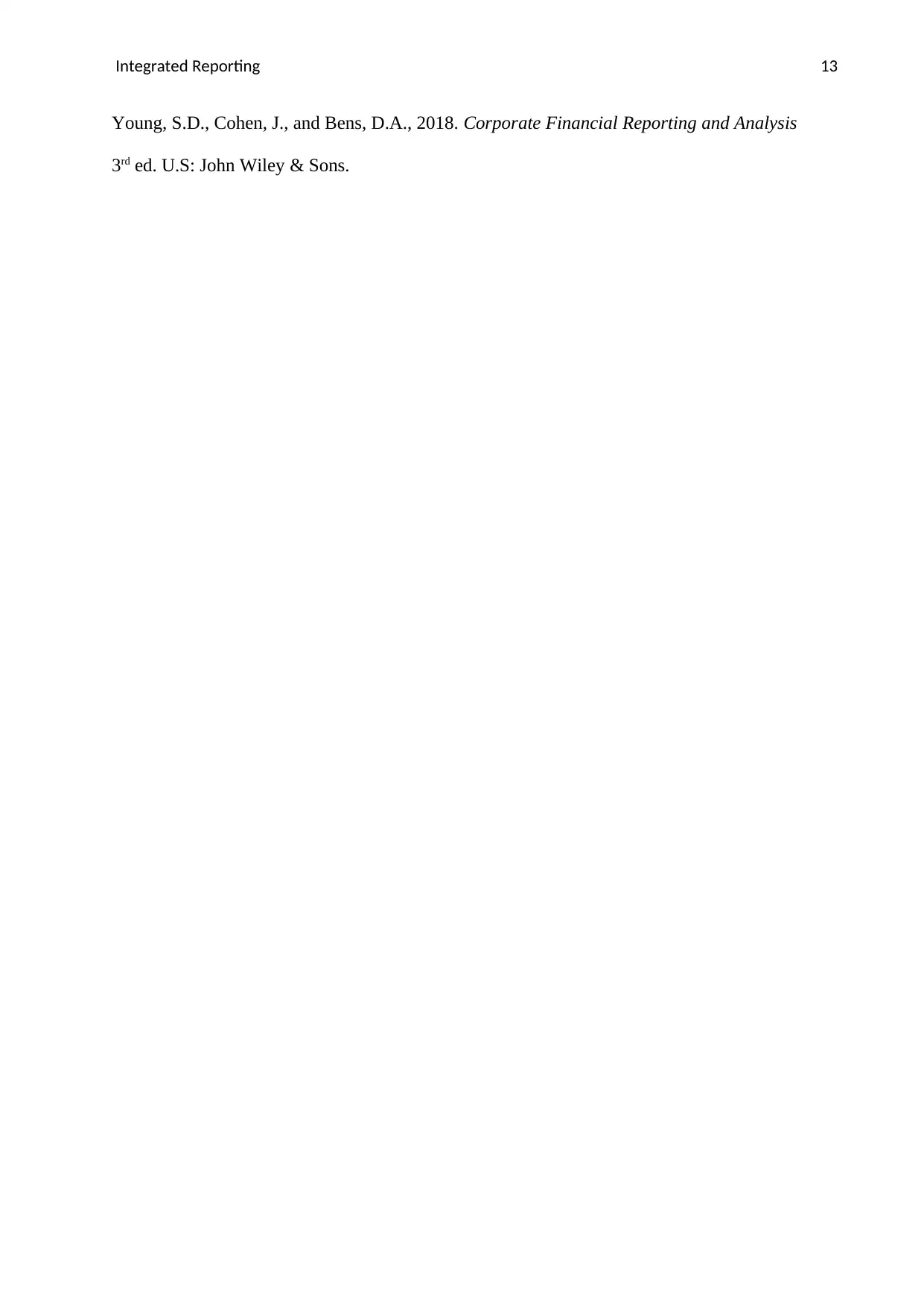
Integrated Reporting 13
Young, S.D., Cohen, J., and Bens, D.A., 2018. Corporate Financial Reporting and Analysis
3rd ed. U.S: John Wiley & Sons.
Young, S.D., Cohen, J., and Bens, D.A., 2018. Corporate Financial Reporting and Analysis
3rd ed. U.S: John Wiley & Sons.

Integrated Reporting 14
1 out of 15
Related Documents
Your All-in-One AI-Powered Toolkit for Academic Success.
+13062052269
info@desklib.com
Available 24*7 on WhatsApp / Email
![[object Object]](/_next/static/media/star-bottom.7253800d.svg)
Unlock your academic potential
© 2024 | Zucol Services PVT LTD | All rights reserved.





